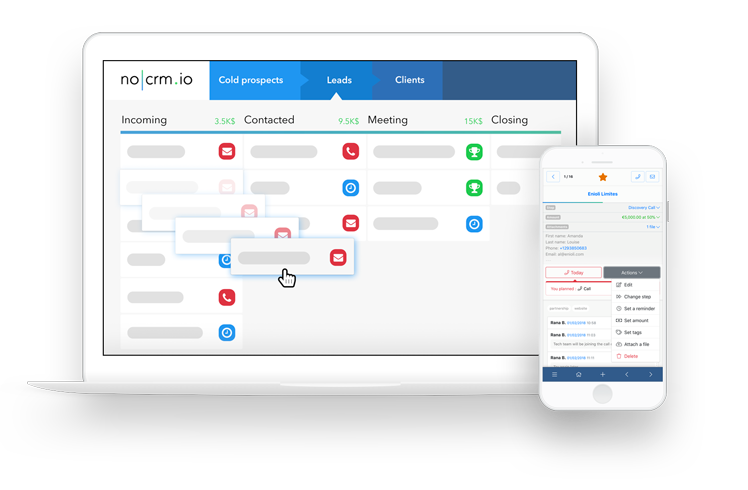All there is to know about SPIN Selling
The SPIN Selling method was developed by psychologist and researcher Neil Rackham between 1974 and 1984. Over this decade, he studied so-called ‘traditional’ sales methods, and examined the work of salespeople in over 35,000 calls.
His study’s results highlighted the driving forces of sales effectiveness. Indeed, he asserts that a sale’s success is particularly linked to the order in which questions are asked by a salesperson.
The study’s results stem from Rackham’s observation that potential customers do not necessarily want to close the sale, but rather to be listened to by the person they are on the phone with.
Salespeople (whose main objective is to sell) must therefore take into account the wishes and needs of potential customers and adapt sales methods accordingly. The SPIN Selling method developed by Rackham gives salespeople the means to accurately question prospects and to ensure a successful sale.
What is SPIN Selling?
Neil Rackham’s study
In the late 1970s, Neil Rackham, supported by major firms, began a wide-ranging research project on sales techniques. For over a decade, his team studied over 35,000 sales interviews in several countries.
The aim of the study was to validate commonly used sales techniques at the time. However, this extensive research’s results are surprising. His bestseller SPIN Selling is still widely read and studied today. Indeed, the SPIN Selling method was confusing at the time Neil Rackham developed it: it was at odds with what salespeople had always been taught.
SPIN Selling: a definition
SPIN Selling is a sales technique that turns prospects into real customers. The method is based on a series of questions that a salesperson must ask the prospect.
This method aims to gain the prospect's trust. Rackham's book presents the SPIN Selling method as an ideal methodology for conducting sales interviews, which places active listening as a major priority.
The benefits of the SPIN Selling method
This method’s effectiveness explains its success. It is in the interest of all salespeople to know and use it, since it ensures that a sale is concluded in a fruitful way.
By asking the right questions in the right order, salespeople engage in active listening, hereby allowing potential customers to open up. Hence reassured, prospects can easily verbalise their needs, interests and fears. They speak freely, and a relationship of trust is built between the salesperson and the prospect.
The existence of a trust relationship is essential in a contractual sales relationship. Although customers and salespeople may not meet very often, this should not prevent building a trust relationship. Even by phone, two human beings are conversing and establishing a relationship.
The SPIN Selling method puts people and trust back at the heart of the sales process. Because they are reassured, prospects are more inclined to contractualise, and may even prioritise products or services offered by a salesperson they trust over those of another firm.
Questioning the main ‘traditional’ sales principles
The SPIN Selling method challenges several sales principles previously considered as crucial. This framework overturns most of these, as listed below.
- Salespeople should not ask many open-ended questions to ensure a sale is closed;
- The closing is not the most important phase of the interview in ensuring a sale’s success;
- Even if salespeople manage to anticipate their prospect's questions, it isn’t usually enough to close a sale.
What are the 4 phases of the SPIN Selling method?

The four phases of the SPIN Selling method are more or less time-consuming. This depends on the product or service offered, the customer, the context, and much more. The most important is getting to the subsequent phases.
Progression occurs naturally through the prospect's actions. For instance, the prospect asking for a quotation to be drawn up for them is a significant step. This progression is always well received both by the salesperson and the potential customer, hereby getting a natural feeling of satisfaction.
The opening phase
This is the first phase, or opening phase. This step builds a relationship of trust between the prospect and the salesperson. One must not talk about the products or services exhaustively, but rather take advantage of this step to learn more about the prospect (their needs, interests, problems, etc.) The given information at this stage must be relevant to the prospect's needs: it must only concern things to which the prospect has referred to.
The investigation phase
The investigation phase is all the more essential since it is a greater in-depth investigation of the prospect. Once again, active listening should be encouraged.
The investigation allows the salesperson to precisely understand the potential customers’ issues and difficulties and to see how the offered products or services can be a solution to the latter. This is also when the salesperson tries to find out who is making the final decision and what elements should be taken into account in the decision-making process.
The demonstration phase
This third phase, or Demonstrating Capability Stage, is the opportunity for the salesperson to talk about their company, products and services (finally!) By listening to prospects’ needs, salespeople can choose the main arguments to convince them.
The proposed solution must eliminate competition. The prospect must understand that what the salesperson is demonstrating is an indispensable solution for them.
The commitment phase
Every exchange ends with the Obtaining Commitment Stage, ending when the sales process ends. As such, if the salesperson is effective in making the prospect place an order, the commitment stage is over. The prospect is now a customer.
This phase may be extended, especially if the prospect makes a step forward without committing to the sale’s conclusion, or if the sale is still in progress. For instance, a quotation or a later appointment may be requested.
If the sale is not concluded and the customer is not interested, then this phase also ends. The salesperson should consider the lost sale but move on to work with other prospects.
What are the 4 questions of the SPIN Selling method?
There are 4 types of questions that a salesperson must ask a prospect: situation, problem, involvement and result questions.
Personalised call scripts developed by noCRM enable taking all of these question types into account and asking the prospect the best possible questions to qualify them.
Situational questions
Situational questions create initial contact with a prospect and detail their environment. Salespeople must obtain background information on their work, such as work process, tools used and particular organisation.
For example, a sales assistant may ask: ‘What is your job?’ ‘Are you the decision-maker?’ ‘What is your turnover?’ ‘How many people do you currently employ?’
However, salespeople need to develop specific scripts according to their products or services and prospects. These questions must be adapted accordingly.
Problem questions
When asking problem questions, salespeople want to elucidate the prospect's needs, challenges and issues.
For instance, the following questions may be asked: ‘What are your market’s limitations?’ ‘How do you find this tool?’ ‘Do you have any problems using it?’ Again, these questions should be personalised.
Involvement questions
These questions aim to get prospects as involved as possible. The latter should be aware of the limitations and problems associated with their situation. They must be able to analyse their situation in order to change it for the better.
These questions should not be a way to sell a solution directly, but rather to raise new questions. Each situation requires specific involvement questions.
For instance, ‘What are the training costs associated with your current tool?’ or ‘What are the results of your current process on your production?’ are interesting questions in this case.
Outcome questions
These outcome questions concern the needs to be met, once the prospect has identified their problems. The challenge here is to prepare the prospect for a potential sale.
Several open-ended questions should be asked. This must always be done before presenting the product or service’s advantages. For instance: ‘What would be the benefits of a change of method?’ or ‘Are you considering another way of achieving your objectives?’ are good questions to ask.
By deploying the SPIN Selling method, salespeople listen carefully to prospects, understand their particular needs and respond with great consistency.
Asking questions is not always enough to bring out the information that every salesperson needs to offer a solution. The SPIN Selling method ensures that salespeople have all the cards in hand to close sales and turn prospects into customers.
